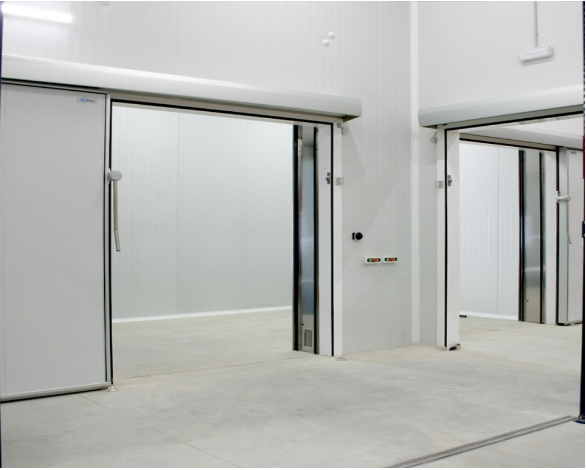Industrial cold rooms are an essential part of the logistics industry, providing a controlled environment for the storage of temperature-sensitive products. The choice of doors for cold rooms is critical since they play a crucial role in maintaining the temperature and preventing the loss of cold air. Sliding doors are becoming an increasingly popular option for cold rooms in the logistics industry as they offer several benefits, including energy efficiency, cost savings, and space utilization. In this article, we will explore the benefits of sliding doors for industrial cold rooms, the factors to consider before installation, the types of sliding doors available, maintenance and repair, safety measures, and cost comparison with other types of doors.
Introduction to Sliding Doors for Industrial Cold Rooms
If you have ever walked into a large grocery store, you have probably seen a cold room – a refrigerated space used to store perishable goods. But did you know that industrial cold rooms are also used in the logistics industry to store and transport temperature-sensitive products? These cold rooms need to be tightly sealed to maintain the required temperature and humidity levels. One popular solution for industrial cold rooms is sliding doors that provide easy access while reducing energy waste.
What are Industrial Cold Rooms?
Industrial cold rooms are large-scale refrigerated spaces used for storage and transportation of perishable goods. These cold rooms require careful temperature and humidity control to ensure the quality and freshness of the stored goods. They are commonly used by the food, beverage, pharmaceutical, and healthcare industries.
Why are Cold Rooms Essential in the Logistics Industry?
In the logistics industry, cold rooms are critical for the safe and efficient storage and transportation of perishable goods. These goods include fresh produce, dairy products, meat, frozen food, and pharmaceuticals. Cold rooms help to maintain the quality and freshness of the products, reducing the risk of spoilage and waste. This, in turn, helps to ensure customer satisfaction and reduce costs for the logistics industry.
Overview of Sliding Doors for Cold Rooms
Sliding doors are a popular solution for cold rooms in the logistics industry. They offer easy and efficient access to the stored goods while reducing energy waste by minimizing the amount of cold air that escapes when the door is opened. Sliding doors are also available in a range of materials, styles, and sizes to suit different cold room requirements.
Benefits of Using Sliding Doors for Cold Rooms in the Logistics Industry
Energy Efficiency
Sliding doors are energy-efficient, reducing the amount of cold air that escapes when the door is opened. This helps to save energy and reduce operating costs.
Cost Savings
Sliding doors are cost-effective to install and operate, making them a popular choice for cold rooms. They are also durable and require minimal maintenance.
Space Utilization
Sliding doors require less space to operate than swing doors, making them a better solution for cold rooms with limited space. They also improve the flow of goods in and out of the cold room.
Improved Productivity
Sliding doors provide easy and efficient access to the stored goods, reducing the time and effort required to move goods in and out of the cold room. This helps to improve productivity and reduce labour costs.
Factors to Consider Before Installing Sliding Doors in Industrial Cold Rooms
Size of the Cold Room
The size of the cold room will determine the size of the sliding door needed. The door should be large enough to accommodate the goods being stored and transported, while still maintaining the required temperature and humidity levels.
Material of the Sliding Door
The material of the sliding door is important for maintaining the required temperature and humidity levels inside the cold room. Common materials used for sliding doors include steel, aluminium, and insulated panels.
Temperature Control Requirements
The sliding door must be able to maintain the required temperature and humidity levels inside the cold room. This will depend on the type of products being stored and transported.
Environmental Concerns
Sliding doors should be designed to be environmentally friendly, reducing energy waste and using sustainable materials whenever possible.
Types of Sliding Doors Suitable for Cold Rooms in the Logistics Industry
Manual Sliding Doors
Manual sliding doors are the most common type of sliding door used in cold rooms. They are durable, cost-effective, and require minimal maintenance.
Automatic Sliding Doors
Automatic sliding doors use sensors to open and close, offering a hands-free option for easy access to the cold room. They are ideal for cold rooms with high traffic volumes.
Biparting Sliding Doors
Biparting sliding doors feature two panels that slide in opposite directions, providing a larger opening and easier access for larger goods.
Tandem Sliding Doors
Tandem sliding doors feature two or more panels that slide in the same direction, providing a wider opening for larger goods and faster access.
Maintenance and Repair of Sliding Doors in Cold Rooms
Regular Inspection and Cleaning
Regular inspection and cleaning of sliding doors in cold rooms is crucial to ensure their functionality and longevity. Dirt and debris can accumulate in the tracks, which can cause the doors to become difficult to open and close. A regular cleaning schedule using appropriate cleaners is recommended to keep the doors in good shape.
Common Maintenance Issues and Solutions
Some common maintenance issues with sliding doors in cold rooms include worn-out rollers, tracks, and seals. Regular lubrication of the rollers and tracks can reduce wear and tear, and replacing worn-out seals can help maintain the desired temperature inside the cold room.
Repairing Sliding Door Components
If sliding door components are damaged, they can be repaired or replaced. Professional technicians can perform these repairs and replacements on-site to minimize downtime. Regular maintenance can help identify any potential issues before they become major problems.
Safety Measures When Handling Sliding Doors in Cold Rooms
Safe Operation Procedures
Safe operation procedures should be followed when handling sliding doors in cold rooms. This includes ensuring that the doors are properly aligned and that there are no obstructions in the tracks. Operators should also ensure that they are not placing themselves in harm’s way when opening and closing the doors.
Correct Use of Personal Protective Equipment (PPE)
Wearing appropriate personal protective equipment (PPE) is essential when handling sliding doors. This can include gloves, hard hats, safety glasses, and steel-toed boots. PPE should be provided and worn to reduce the risk of injury.
Training for Employees
Training employees on how to properly operate and maintain sliding doors in cold rooms is essential for their safety. Employees should be trained on safe operation procedures, the correct use of PPE, and the importance of regular maintenance.
Cost Comparison of Sliding Doors with Other Types of Doors in Cold Rooms
Initial Installation Costs
The initial installation cost of sliding doors in cold rooms can be higher than other types of doors, but it depends on the specific requirements of the cold room. Sliding doors may be more expensive to install if the cold room needs a custom design or larger than standard doors.
Maintenance Costs
Maintenance costs for sliding doors in cold rooms are generally lower than other types of doors. Regular maintenance can help prevent major repairs, which can be costly.
Energy Costs
Sliding doors in cold rooms can help reduce energy costs by minimizing heat loss and maintaining a consistent temperature. This can result in significant savings on energy bills over time.
Conclusion and Final Thoughts on Sliding Doors in Cold Rooms for the Logistics Industry
In conclusion, sliding doors in cold rooms offer many benefits for the logistics industry, including energy efficiency, safe operation, and reduced maintenance costs. Regular inspection, cleaning, and maintenance are essential to ensure the longevity and proper functionality of these doors. When handled safely and maintained regularly, sliding doors can provide a cost-effective and efficient solution for industrial cold rooms. In conclusion, sliding doors for industrial cold rooms are an excellent investment for the logistics industry, providing several benefits, including energy efficiency, cost savings, and space utilization. With proper maintenance and operation, sliding doors can last for many years, providing a reliable solution for temperature control. By considering the factors outlined in this article, the logistics industry can make an informed decision on the type of sliding door suitable for their cold rooms.
About Us
DANA Steel (www.danasteel.com) is an ISO 9001:2015 certified company, with the rich experience of around three decades, we have always thrived hard in order to bring revolutionary changes to the steel industry; We have our state of the art Cold Rolling Mill (CRM Complex) Situated in DIC (Dubai Industrial City) we proudly manufacture our products in Dubai, UAE.
Our market extends over a wide demographic as we export over products to around 50 countries including counties from the Indian subcontinent (Bangladesh, India, Nepal); South-East Asian countries (Indonesia, Thailand, Vietnam); Middle-East countries including members of GCC (GCC-Saudi Arabia, Bahrain, Kuwait, Jordan, and Oman (Ibri, Salalah, Muscat, Sohar, Nizwa, Barka). We also have our markets extended to Africa (Djibouti) and South America. With our constant commitment to customer contentment, we can provide competitive prices and faster shipment to all our valuable clients.
Feel free to contact in case of any enquiry. Listed below are the mediums through which you can reach us out!
WhatsApp – +971507983153
Tel – 0097142217273
Email – info@danagroups.com / info@danasteel.com



